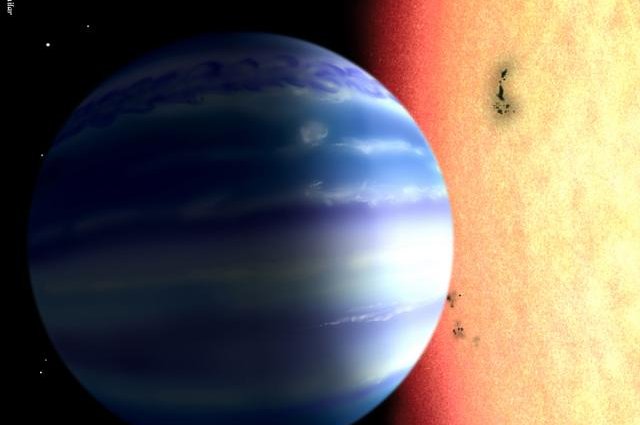An artist's conception of a hot-Jupiter
extrasolar planet orbiting a star similar to tau Boötes. (David Aguilar, Harvard-Smithsonian Center for Astrophysics)
COLLEGE STATION, Pa., Feb. 26 (UPI) -- Astronomers have detected water in the atmosphere of a planet as big as Jupiter, but much hotter, that orbits the star tau Boötis -- one of two stars in a binary system some 51 light-years away.
The scientists discovered the planet, now named tau Boötes b, and its watery atmosphere using a new technique, one they think will help them locate additional water-bearing planets.
"Planets like tau Boötes b, which are as massive as Jupiter but much hotter, do not exist in our solar system," explained Chad Bender, co-author of a paper detailing the discovery. "Our detection of water in the atmosphere of tau Boötes b is important because it helps us understand how these exotic hot-Jupiter planets form and evolve. It also demonstrates the effectiveness of our new technique, which detects the infrared radiation in the atmospheres of these planets."
This isn't the first time water vapor has been detected in a faraway planet's atmosphere. But previous techniques required very specific circumstances. A planet couldn't be too far away from the host star, for example. Another detection method required a planet to be passing directly in front of its host star when being observed from Earth.
The new infrared technique developed by Bender and his fellow researchers at the Penn State Department of Astronomy and Astrophysics is much more flexible, opening up a larger swatch of the universe to water detection.
New super-powered infrared telescopes like the James Webb Space Telescope and the Thirty Meter Telescope -- both currently in development -- could help astronomers scour even more of the universe for water, honing in on planets that are colder, farther away from their host star and more likely to have water.
The details of this new technique and the discovery of tau Boötes b was recently published in The Astrophysical Journal Letters.
[Penn State]
[The Astrophysical Journal Letters]















